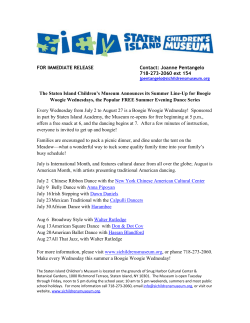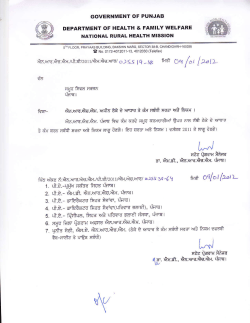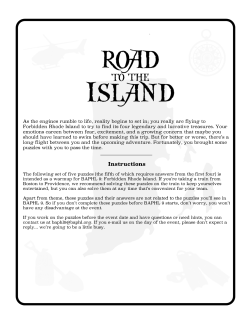
Document 173546
Anything typed in blue and underlined is a hyperlink. You can click on it and it will take you to a webpage or document. Island of the blue dolphins By Scott o’Dell AR Level: 5.4 Preparing your notebook ISBN-13: 978-0547328614 1. Number the pages of your notebook (front and back) up to page 7. It’s usually a good idea to skip the first page. It gets so much wear and tear, it frequently tears out. 2. Page 1 will be the title page. Label it Island of the Blue Dolphins and draw a picture to go along with it. 3. The narrator describes the physical setting in detail throughout the book. If you purchased your own copy, every time the setting is described, underline it or mark it in some way. If you are borrowing a book, use post-it notes or take notes in your notebook. Be sure to write down the page numbers so you can find it later to create your own map of the island on page 2. 4. Tape or glue a map of the Channel Islands on page 3. 5. Pages 5 will be your table of contents. Label the top of the page and as you add notes, complete activities, and answer questions, add the page titles and numbers to your table of contents. 6. As you read you’ll notice the narrator frequently mentions animals. Keep a list of all the animals mentioned in the story on page 6. Mark the page with a post-it note to find it easily later. 7. Go to the back of your notebook and count inward 5 pages. This will be your glossary. Add words you find on the driftwood (like the piece in the right corner of this page) on ily o eas t m each page to your glossary and look up the definitions—include ry.co tiona c i rds. d . y wo ww r w a s e them too. Mark the page with a post-it note so you can s glo pag your k the o r t a s m n io easily find it later. Book efinit ord d the w up look ISLAND OFTHE BLUE DOLPHINS Chapter 1 1. Who is the narrator? How old is the narrator? 2. What is the setting of the story? What is the name of the village? 3. This visitors come in a red ship with red sails. Why do you think the author chose this color? What do you think of when you think of red? Parley means to speak, usually a conference between enemies under a truce. 4. Where are the Aleutian Islands from where the Russians came? (Click on the name to the right of the map) 5. If you were in charge of the island, would you accept Captain Orlov’s offer? Why? Why not? 6. The Aleuts were hunting sea otters. How are sea otters unique among animals? your o t led ncea o c e and n i v a r Add ary. gloss ISLAND OFTHE BLUE DOLPHINS Become a National Parks Junior Webranger. Write down your username and password on the inside cover of your notebook. Log in to your ranger station and complete the following activity: See what life was like in Alaska for the Aleuts who came with Captain Orlov. >Click on Find Activities! at the left of the screen >Click on History >Choose Arctic Artifacts ISLAND OFTHE BLUE DOLPHINs Santa Cruz island flipped over. The island described by Scott O’Dell. The island where the real Lone Woman lived. The map on the right shows what the land under the ocean looks like. The brown parts are land. The darker the color, the deeper the water is in that particular part of the ocean. Can you see the islands? This type of map is called a topographical relief map. ISLAND OFTHE BLUE DOLPHINs Chapters 2&3 1. Use Karana’s descriptions to draw the island on page 2 of your notebook. 2. Why did the chief warn the villagers not to visit the Aleut camp? 3. What good fortune came to the villagers? 4. Why did Karana become angry when she saw hunters? San Nicolas Island where the real “Lone Woman” lived. 5. For a long time, scientists thought sea otters were extinct because they were hunted so much. Check out this website for more info about the otters and what happened to them. Where did they find sea otters? 6. Why were the villagers concerned when they knew the Aleuts would soon leave the island? 7. Karana tells distances in leagues. Look up “league” and see how far it is in miles. Add it to your glossary. n icing, strew jo e r , ly g in r A dd s p a ur glossary. o y to lt e p d an Don’t forget to add to your list of animals on page 6. ISLAND OFTHE BLUE DOLPHINs 1. Chapters 4&5 What caused a fight between the Aleuts and the villagers? 2. What happened to Chief Chowig? What did Karana say was the reason for this? 3. Karana harvests abalone for food and tools. What is abalone? 4. She prefers red abalone. Why are they called red abalone? 5. Much of the time spent is in hunting and gathering food. Why? How is that different from today? 6. Why was life not so peaceful at Ghalas-at after the Aleuts went away? 7. Karana says, “So hard did the women work that we really fared better than before when the hunting was done by the men.” Why do you think this happened? What would make them work so hard? Why didn’t the men Add pursue, fo wl, and shirkers to usually work as hard as the your glossary. women are now? ISLAND OFTHE BLUE DOLPHINs Chapters 6&7 1. The people measure time by the sun and moon. When Karana says Kimki was gone “one moon,” how long do you think that is? Go to this site and see if you’re correct. 2. Who is Matasaip? 3. What happened to Kimki? 4. Why do you think Ulape drew a blue mark on her face? 5. Why did Karana jump off the ship into the water? 6. What do you think will happen to Ramo and Karana? This is someone’s first attempt at making a yucca fiber skirt. I’m guessing Karana was much more skilled so her skirt was even more impressive. to rlorn o f d n ain, a v , e le out, f t s d Ad sary. s o l g your ISLAND OFTHE BLUE DOLPHINs 1. Why did Ramo not want the ship to come back for them? 2. Describe the “rites of manhood.” Do we have rites of manhood now? What are boys expected to do or know how to do? 3. Why was Karana afraid when Ramo went alone to get the canoes? 4. Why did she decide not to go after him? Chapter 8 Slunk is the past tense of slink. It means to move about slowly and usually in shame. Watch this video to see how a spit is formed. It’s on Youtube, so be sure to ask your parent’s permission first. This is an image of Chumash people and their canoe. They lived on the mainland near Karana’s island. This is an example of a seaweed basket. Karana and Ramo would not have taken the time to add shells to theirs. your o t h c t d swi n a , r i la ged, r o g Add ary. gloss ISLAND OFTHE BLUE DOLPHINs Chapter 9 1. Why do you think Karana set her village on fire? 2. Why did Karana sleep on a high rock? 3. Why do you think she threw the jewels away instead of keeping them? 4. It was against the law of the tribe for women to make weapons. What did she think might happen to her if she made weapons? (List four things) 5. What things do we commonly say girls can’t or shouldn’t do now? Why do you think people believe this? s evice r c d an new, i s , e orbad f d d A . ssa r y o l g r you Sunset over the Channel Islands. to ISLAND OFTHE BLUE DOLPHINs Karana had to make all of her tools and weapons from items she could find. See how tools have changed. Log in to your ranger station at the National Park Service Webranger site >Click on the Find Activities! tab on the left >Click on History >Choose Yesterday and Today Chapter 10 ISLAND OFTHE BLUE DOLPHINs 1. Why did Karana decide to leave the island? 2. What did she use as a guide to find her way to the east country where Kimki had gone? (Name two things.) ling knee A dd ary. gloss 3. Why did she decide to turn back to the island? 4. What good fortune did she have that helped her to get back home? 5. How did Karana feel when she finally reached the island? Read about how people from long ago found their way when they were out in the open ocean. and yo u r o t k dus ISLAND OFTHE BLUE DOLPHINs Karana and her people could not have survived without the creatures of the sea. Find out more. Log in to your ranger station at the National Park Service Webranger site >Click on the Find Activities! tab on the left >Click on Nature >Choose the Ocean Life Matching Game Then, >Click on Science >Choose Exploring Tidepools ISLAND OFTHE BLUE DOLPHINs Chapters 11 & 12 1. Karana had to build a house since she had burned all the houses in the village. Give three reasons why she decided to build her house on the headlands. 2. What did Karana use to build a fence and why did she build the fence before she built the house? 3. What are sai-sai? What did Karana use them for? Watch this video to see what the fish are usually called and learn about their strange mating habit. 4. Why did she want to kill a male sea elephant (Northern Elephant Seal)? After reading about them, what do you think they look like? Search the web for images of elephant seals. Is this what you imagined from O’Dell’s description? How does your imagined picture of an elephant seal differ from the real one? How much can a male elephant seal weigh? (Be sure to scroll down and listen to what an elephant seal sounds like!) 5. Read over the description of Karana’s new house and en d om n a , fence carefully, then draw a picture to show ng afeni e d , h what it looks like based upon the ackis r b d Ad sary. s o l g ur description in the book. to yo ISLAND OFTHE BLUE DOLPHINs 1. How did Karana hurt her leg? 2. What happened when Karana went to the ravine to get water? 3. Why did she spend six days in the cave? 4. Why did she decide to make the cave another house? 5. What did Karana find when she returned to the place where the sea elephants lived? Chapters 13 & 14 be to o l d n sh, a a g , ng llowi e b Add . ssa r y o l g r you ISLAND OFTHE BLUE DOLPHINs Karana stays in the cave her ancestors once used. She describes how her ancestors “cut figures in the stone” sides of the cave. Carved drawings are known as petroglyphs. Other Native Americans left behind petroglyphs too. Log in to your ranger station at the National Park Service Webranger site >Click on the Find Activities! tab on the left > Click on History >Choose Stories from the Past ISLAND OFTHE BLUE DOLPHINs Chapter 15 1. Where had the yellow-eyed dog come from? 2. How did Karana get the dogs to come out of the cave? 3. What did she do when she found the wounded dog? 4. Why do you think Karana “did not send the arrow”? 5. What did Karana do when she left the house at dawn and what did she find when she returned each day? 6. What did Karana decide to name the dog and what does the name mean? your o t d nawe g d an rcass a c Add ary. gloss ISLAND OFTHE BLUE DOLPHINs 1. Why did Karana want to make her canoe smaller? How did she do it? Chapters 16 & 17 Add planks, barbed, and foreleg to your glossary. 2. What kept Karana from being lonely? 3. Why did Karana think that finding the sea cave was a great discovery? 4. Read the description of the devil fish and draw a picture to match the description. 5. Karana could have killed the attackers, but she decided not to help Rontu. Why? What would you have done? 6. What did Rontu do after the battle was over? What do you think that action means? ISLAND OFTHE BLUE DOLPHINs Chapters 18 & 19 1. Where did Karana get the birds that became her friends? What did she name them? 2. Why did she cut the tips of their wings? 3. What did Karana use to make her clothes (skirt, belt, sandals, and in her hair)? 4. Nature has given all animals a natural defense. How does the devil fish protect itself from attackers? 5. Go to this site to learn more about octopuses. Draw a picture of one and write down something you learned about them. 6. How does the devil fish swim? The devilfish Karana kills is actually an octopus. She said Rontu was injured by the octopus’s beak. At left is a photo of an octopus beak. Ouch! Add flailin g, st your alk, a gloss nd le ary. eche s to Chapters 20 & 21 ISLAND OFTHE BLUE DOLPHINs 1. What are cormorants? Why did Karana kill them? List two facts about cormorants. 2. What did Karana discover in the cave that made her afraid? 3. Why did she move everything from her house to the cave at the ravine? 4. Karana wanted to make it look as if no one had lived in her house for a long time. Why do you think she did this? 5. What did Karana find when she returned to the cave? 6. What do you think will happen next? ldom e s d Ad ary. gloss your o t awled r p s and ISLAND OFTHE BLUE DOLPHINs 1. Why do you think Karana decided to speak to Tutok? 2. Why did Tutok give Karana a gift? Why did Karana work so hard to make a gift for Tutok? Why do you think this was so important? 3. What did Karana do with the otter the Aleuts left behind? 4. What did she name her new friend? 5. Why didn’t Mon-a-nee leave the small pool? 6. Reread the last paragraph in chapter 22. Why do you think the island suddenly seemed very quiet? epro Add r ac Chapters 22 & 23 s r glos u o y h to ary. ISLAND OFTHE BLUE DOLPHINs 1. Who made up Karana’s new family? 2. Why did Karana change the otter’s name to Won-a-nee? Chapters 24 & 25 3. What made her decide never to kill another animal? 4.Why did the herd of otters leave Coral Cove in the summertime? 5.How did Karana keep account of the days and years that she lived on the island alone? 6.Rontu went off and did not return. Where did Karana find him and in what condition? 7.Learn more about sea otters. nd ng a i l g d fle Add sary. s o l g ur to yo le hobb ISLAND OFTHE BLUE DOLPHINs A tsunami really was recorded in this area in the 1850s! 1. What are snares and why did Karana make them? 2. What did she name her new dog and what does that name mean? 3. How did Karana shield her eyes from the hot sun? The glasses below work on the same principle. 4. What happened when she went to sleep under her canoe? 5. How did Karana escape the tidal wave? Go to this page and read about earthquakes and tsunamis. Scroll to the bottom to see video of a real tsunami! Add glim pse to yo ur glossa ry. Cha pte r 27 Chapters 26 & 27 has “Lik lots e tw of e o gi xam ants ples “ Th the of p e to y e r so cras n gu nific es o he d atio fw “…t a g a ater n: he o inst islan cea licke eac n h d as d in w othe to a if it as sm r” ( l o l th pa g we r oth For e e 16 e ve an d c a de r e 8). ry t vice yell own finit s o i r … w e i e o ” (p d” ( n the xamp ag e pag an d it le o of per link e l 168) a so n i f pe 169) y ag ed p . fica . rson a ag e i nst ifica tion, an d the clic tio use it in n or ch k on t he oo a pa ragr se one word. a ph from Writ . the e your list on ISLAND OFTHE BLUE DOLPHINs 1. What did Karana lose from the great waves? 2. Where did she get wood to build a new canoe? 3. What do you think Karana was thinking about when she was deciding whether or not to hide? 4. The men made a new garment for Karana to wear. Why? 5. The man in the gray robe wore an ornament around his neck. Who was this man and what do you think this ornament was? 6. There really was a “Lone Woman of San Nicholas.” ๏ See what she looked like here ๏ Read more about her here. ๏ Listen to one of the songs she sang here. ๏ What do you think happened to the Lone Woman of San Nicholas’s family? What evidence did you find in the stories of her that support your guess? your o t s r rouse t d n a sture e g Add ary. gloss Chapters 28 & 29 ISLAND OFTHE BLUE DOLPHINs ๏ Did you remember to keep adding animals to your list? How many animals do you have listed? ๏ Want to know more about this story? Check out this amazing webquest to learn more about the book and the real story of the “Lone Woman of San Nicholas.” ๏ Want to know more about tide pools? Learn more about this fragile ecosystem. ๏ Watch videos and learn about some of the animals Karana lives with, befriends, and survives upon. ๏ Even more information about the animals can be found at the Sea World/Busch Gardens site. Channel Island fox Works Cited "Abalone." ThinkQuest. Oracle Foundation, n.d. Web. 15 June 2013. Adam. Santa Barbara Channel Basin. Digital image. Sensual Animist. N.p., 16 Mar. 2012. Web. 16 June 2013. Algae. Digital image. Algae. N.p., n.d. Web. 17 June 2013. "ANIMAL INFO - Animal InfoBooks." ANIMAL INFO - Animal InfoBooks. N.p., n.d. Web. 17 June 2013. "Archaic Indians of the Lower Pecos by Scott Walters." Archaic Indians of the Lower Pecos by Scott Walters. N.p., n.d. Web. 18 June 2013. Arthur. Grunion. Digital image. Arthur's Sea Fish Clipart Page 2. N.p., n.d. Web. 15 June 2013. Barrow, Mandy. "Facts about the Moon for Kids." Facts about the Moon for Kids. Woodlands Junior School, n.d. Web. 16 June 2013. "Basic Facts about Sea Otters." Sea Otter. Defenders of Wildlife, n.d. Web. 15 June 2013. Black Onyx Tumbled Stone Necklace. Digital image. Black Onyx Tumbled Stone Necklace. Enchanté Stones, n.d. Web. 17 June 2013. Boarding DRMC. Digital image. Boarding DRMC. N.p., n.d. Web. 15 June 2013. Bobbi. Bobbi's Blog. Digital image. Bobbis Blog. N.p., n.d. Web. 18 June 2013. <http://bobbiblogger.wordpress.com/2013/03/21/sea-otters-hold-hands-whenthey-sleep/>. Brown, Stacey Lynn. Driftwood. Digital image. - The Photography Network. Picture Social, 15 Mar. 2008. Web. 15 June 2013. "California Coastal Commission, Public Education Program. 2005 Photo Contest Gallery." California Coastal Commission, Public Education Program. 2005 Photo Contest Gallery. N.p., n.d. Web. 18 June 2013. Carr, KJ. Red Sails In The Sunset. Digital image. EBay. N.p., n.d. Web. 16 June 2013. Chandra, Nalini, and John Percy. "Celestial Navigation." Astronomy. Astronomy Magazine, n.d. Web. 17 June 2013. Channel Island Fox. Digital image. Lincoln Park Zoo. N.p., n.d. Web. 18 June 2013. Chumash Spear. Digital image. Sold Australian. N.p., n.d. Web. 16 June 2013. Dolphins. Digital image. Oceans Initiative RSS. N.p., n.d. Web. 16 June 2013. Everything You Otter Know about Sea Otters. N.p.: n.p., n.d. Suzieszterhas. Web. 18 June 2013. <www.suzieszterhas.com/a/pdf/RRNOV10_6-11Ottersweb.pdf>. "Examples of Personification." Examples of Personification. N.p., n.d. Web. 17 June 2013. "GENERAL VIEW - Cemetery, Point Hope, North Slope Borough, AK." 1. GENERAL VIEW - Cemetery, Point Hope, North Slope Borough, AK. N.p., n.d. Web. 16 June 2013. "Giant Pacific Octopus." Exhibit at the Monterey Bay Aquarium. Monterey Bay Aquarium, n.d. Web. 17 June 2013. Gliozzo, Jan, Matt Graham, Yolanda Kobayashi, and Carolyn Alley. "Explore Island of the Blue Dolphins." Explore Island of the Blue Dolphins. N.p., n.d. Web. 16 June 2013. Jay, Michael. Southern Sea Otter. Digital image. Los Padres ForestWatch. N.p., n.d. Web. 15 June 2013. Kennedy, Joanne. My Little Cottage in the Making: SAND DOLLARS AND A SPECIAL STORY ABOUT THEM. Digital image. My Little Cottage in the Making: SAND DOLLARS AND A SPECIAL STORY ABOUT THEM. N.p., Aug. 2011. Web. 15 June 2013. Lencer. Channel Islands of California. Digital image. Wikipedia. Wikimedia Foundation, 06 Dec. 2013. Web. 15 June 2013. "The Lone Woman of San Nicolas Island." The Lone Woman of San Nicolas Island. N.p., n.d. Web. 17 June 2013. "Malibu Lagoon Chumash-Polynesian Connection." Malibu Lagoon Chumash-Polynesian Connection. California Parks and Recreation, n.d. Web. 17 June 2013. Mangum, Doug. Inspiration Point Sunset. Digital image. SmugMug. N.p., n.d. Web. 16 June 2013. "Northern Elephant Seal." The Marine Mammal Center. The Marine Mammal Center, n.d. Web. 15 June 2013. "Pretty Cormorant | Maine Fly Fishing." Maine Fly Fishing. N.p., n.d. Web. 15 June 2013. "Red Abalone - Haliotis Rufescens." Red Abalone - Haliotis Rufescens. Fish Tech, n.d. Web. 15 June 2013. "San Diego Explained: Grunion Run | Voice of San Diego." Voice of San Diego. N.p., 04 Aug. 2010. Web. 15 June 2013. "Sea Otter." ThinkQuest. Oracle Foundation, n.d. Web. 17 June 2013. Seaweed Basket. Digital image. Winnow Gallery & Goods. N.p., n.d. Web. 16 June 2013. SlatBlinds Shutter Sunglasses. Digital image. Custom Made Slat Blinds Shutter Sunglasses- China Supplier Wholesale Manufacturer. N.p., n.d. Web. 17 June 2013. Swain, Jack. "What Is a Spit?" Youtube. N.p., n.d. Web. 16 June 2013. Timbrook, Jan. "The Lone Woman of San Nicolas Island." The Lone Woman of San Nicolas Island. The Santa Barbara Museum of Natural History, n.d. Web. 16 June 2013. "Weather Wiz Kids Weather Information for Kids." Weather Wiz Kids Weather Information for Kids. N.p., n.d. Web. 18 June 2013. "Webrangers." WebRangers Entry Gate. National Parks Service, n.d. Web. 15 June 2013. Willmott, Grace. Cormorant Wing. Digital image. BBC News. BBC, n.d. Web. 15 June 2013. Yucca Fiber Skirt. Digital image. Paleotools Weblog. N.p., n.d. Web. 16 June 2013. Yuungnaqpiallerput - The Way We Genuinely Live - Masterworks of Yup'ik Science and Survival. Digital image. Yuungnaqpiallerput - The Way We Genuinely Live - Masterworks of Yup'ik Science and Survival. N.p., n.d. Web. 18 June 2013.
© Copyright 2025









